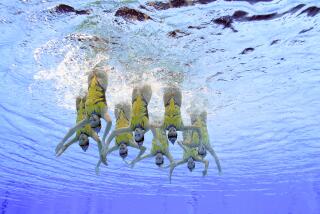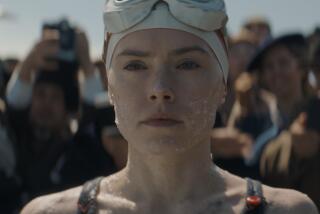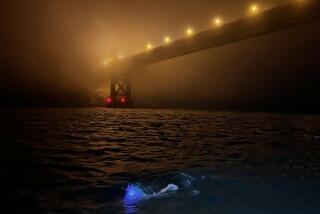Gertrude Ederle, 98; First Woman to Swim Across English Channel
- Share via
NEW YORK — Gertrude Ederle, who was the toast of America and Europe in 1926 when she became the first woman to swim the English Channel, died Sunday. She was 98.
Ederle had spent the last several years living at the Christian Health Care Center in Wyckoff, N.J., about 25 miles northwest of New York City, said Martin Ward, whose wife is one of Ederle’s 10 surviving nieces and nephews. The exact cause of death was not announced.
In a roaring decade where Americans cheered daredevils, few were as celebrated as Ederle, who was 20 when she made her historic swim on Aug. 6, 1926.
“People said women couldn’t swim the channel,” Ederle told Associated Press in a 2001 interview marking the 75th anniversary of her feat. “I proved they could.”
When she returned to her native land, there were celebrations, receptions and a ticker-tape parade for her in New York City, where she was born in 1905, according to the family. She met President Coolidge, was paid thousands of dollars to tour in vaudeville, played herself in a movie (“Swim, Girl, Swim”) and had a song and a dance step named for her.
Only five men had succeeded in swimming the channel before her, and she beat the record by more than two hours.
“I thought it was marvelous, and I thought only Gertrude could have done it,” another top swimmer from the era, Aileen Riggin Soule, said in a 1999 interview. “She had the stubbornness.”
Ederle swam the choppy, treacherous stretch under the most adverse conditions, battling riptides, crosscurrents, driving rain and mountainous seas, as well as a constant threat of floating debris, poisonous jellyfish and sharks.
She left Cape Griz-Nez, France, at 7:05 a.m. and stumbled ashore at Kingsdown, England, 14 hours and 30 minutes later. Because of the stormy weather, she had swum the equivalent of 35 miles in crossing the 21-mile-wide channel.
Yet her time for the crossing stood for 24 years before it was broken in 1950 by Florence Chadwick, who negotiated 23 miles in 13 hours and 20 minutes.
Two tugboats accompanied Ederle, one filled with relatives and friends, and the other with reporters and photographers, some of them seasick. A phonograph played lively tunes to lift her spirit, and those riding in the boats sang, too.
But Ederle said her well-wishers needed to be buoyed more than she did.
“I had to keep joking with them to keep their spirits up,” she recalled. “I remember they sang endlessly: ‘Let Me Call You Sweetheart,’ ‘Sweet Rosie O’Grady’ and ‘After the Ball Is Over.’ But when the storm was fiercest, they all looked as if they were going to a funeral. Every time I stopped, they jumped and said, ‘What’s the matter, Trudy? Everything OK?’ ”
During some of the toughest moments, her trainer, fearful of her well-being, tried to get her to give up, “but I’d just look at him and say, ‘What for?’ ” she recalled.
At the ticker-tape parade, the crowds shouted, “Hello, Miss What-For!”
She was little affected by the fame that followed. She remained what one writer called “an almost old-fashioned girl in a world of flappers.” Soule, who toured with Ederle in a swimming exhibition, recalled her as “a sweet person -- thoughtful, kind. She even wrote poetry.”
Ederle eventually quit touring when the stress got too great.
Ederle was a champion swimmer before her channel swim, holding a string of world records at various distances.
At the 1924 Olympics in Paris, she was hobbled by the stress of travel and turned in a disappointing performance -- by her standards -- of one second-place finish, one third-place finish and a first on a relay team.
In 1925, she swam the 21 miles from the tip of Manhattan to Sandy Hook, N.J., in seven hours, 11 1/2 minutes, bettering the record held by men.
That same year, she made her first try at the English Channel, saying later that she failed only because a worried trainer grabbed her when she briefly began coughing. As soon as someone touched her, she was disqualified.
After giving up her personal appearance tour, Ederle fell down a flight of stairs in 1933, injuring her spine. Battling back, she returned to the spotlight at the 1939 World’s Fair, swimming in a show at the famous Aquacade.
Her hearing hadn’t been good since a childhood bout with the measles, and hours spent in the water aggravated the problem. By the 1940s, she was entirely deaf.
Out of the spotlight, she taught deaf children to swim -- “since I can’t hear either, they feel I’m one of them” -- and participated in some business ventures. Giving few interviews, she lived quietly in Queens for many years.
“I have no complaints,” Ederle said in one interview in the 1950s. “I am comfortable and satisfied. I am not a person who reaches for the moon as long as I have the stars. God has been good to me.”
More to Read
Sign up for Essential California
The most important California stories and recommendations in your inbox every morning.
You may occasionally receive promotional content from the Los Angeles Times.










